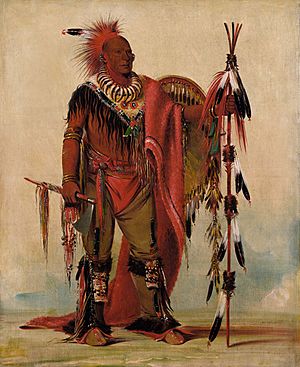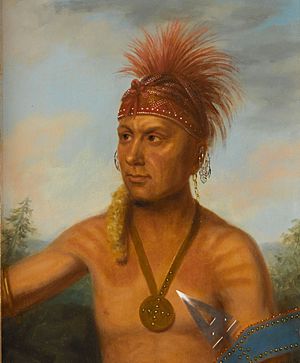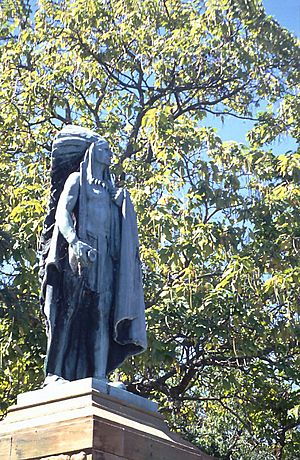Keokuk (Sauk leader) facts for kids
Quick facts for kids
Keokuk
|
|
|---|---|
 |
|
| Born | c. 1780 |
| Died | June 1848 |
| Nationality | Sauk or Sac |
| Known for | Fourth Treaty of Prairie du Chien (1830), Black Hawk Purchase (1832) |
| Spouse(s) | No Kaw Quale Quale |
| Children | Moses Keokuk Caroline Keokuk"Perrigo" |
Keokuk (born around 1780, died June 1848) was an important leader of the Sauk tribe in central North America. For many years, he was known for working peacefully with the U.S. government. Keokuk moved his tribe several times. He always tried to be a good friend to the Americans. His ideas were different from another Sauk leader, Black Hawk. Black Hawk led his people to fight in the Black Hawk War, but they were defeated.
Contents
Early Life and Family
Keokuk was born around 1780 near the Rock River. This area is now part of Illinois Territory. His father was a Sauk warrior. His mother had mixed heritage. He grew up in a village near what is now Peoria, Illinois. Even though he wasn't from a ruling family, he was chosen for the tribal council when he was young.
A Leader's Journey
During the War of 1812, Keokuk convinced his tribe not to leave their main village, Saukenuk. He also urged them not to fight alongside the British and war chief Black Hawk. Many warriors had already left to fight. So, Keokuk was also chosen as a war chief. He successfully protected his village by using his great speaking skills.
In 1824, Keokuk visited Washington, D.C. He traveled with other Native American leaders. One of them was Chief Wapello of the Meskwaki people.
Keokuk's Speaking Skills
Keokuk was known for his bravery and his amazing ability to speak. Many times, he changed the minds of tribal members. Even when everyone else strongly disagreed, he could persuade them. For example, in May 1832, his band was preparing for a war dance. They planned to join Black Hawk against the white settlers. Keokuk stopped the dance and convinced the warriors not to fight.
In 1828, Keokuk moved his tribe across the Mississippi River. They settled near the Iowa River. The next year, a man named Caleb Atwater met him. Atwater described Keokuk as a wise and brave leader. He said Keokuk was honorable and never begged from white people.

Working with Treaties
In July 1830, Keokuk was one of several Native American leaders. They signed the Fourth Treaty of Prairie du Chien with Indian Agent William Clark. This treaty gave land, including Black Hawk's home village of Saukenuk, to the United States.
When Black Hawk returned and found settlers in his village, he decided to fight. But Keokuk managed to keep most of his tribe peaceful. He became one of the "money chiefs." These chiefs helped distribute payments from this and other treaties. Keokuk tried to convince Black Hawk to avoid war. However, the U.S. Army and Illinois militia soon defeated Black Hawk's warriors.
After the war, a special area of land around Keokuk's village in Iowa was protected. This was part of the 1832 Black Hawk Purchase treaty. This treaty ended the war. In August 1833, U.S. officials gave Black Hawk into Keokuk's care. Keokuk was officially recognized as the main chief of the Sauks and Foxes.
Travels and Later Life
In 1837, Keokuk visited Washington, D.C., with other chiefs. They arranged a peace agreement between their people and their old rivals, the Sioux. They also visited New York City, Boston, and Cincinnati. Keokuk's speeches gained a lot of attention. Black Hawk was with the group. Keokuk worried Black Hawk might cause trouble if left behind. Black Hawk died the next year.
In August 1842, Keokuk and some tribal members visited Nauvoo, Illinois. Soon after, he arranged to sell the tribe's land in Iowa. His friend Chief Wapello had passed away earlier that year. So, in 1845, Keokuk's band moved further west into Kansas.
Death and Lasting Impact
Keokuk and his people arrived at their new home near Ottawa, Kansas in 1845. Keokuk died there in June 1848. His son, Moses Keokuk, became the new chief. Moses later moved the tribe to Oklahoma Territory.
Keokuk County, Iowa and the town of Keokuk, Iowa are named after him. Chief Keokuk had never visited the town before it was officially formed in 1834. In 1883, Chief Keokuk was reburied in Keokuk, Iowa. Today, the Chief Keokuk Statue stands in Keokuk's Rand Park. It was designed by Nellie Walker and put up in 1913.
Observations by a Traveler
In May 1832, a Scottish traveler named William Richard Grahame met Keokuk. He wrote about his impressions in his diary. Grahame described Keokuk as a "fine looking man" and a "principal speaker." He felt Keokuk was a true orator. His face was noble and strong. Keokuk was tall, standing five feet eleven inches. He walked with a proud and free step. His voice was powerful and clear when he spoke.
Grahame noted that Keokuk's speeches were easy to translate. He also mentioned that Keokuk was not reckless. He was willing to listen to advice and discuss things. Keokuk was a warrior chief, a rank earned through bravery.



